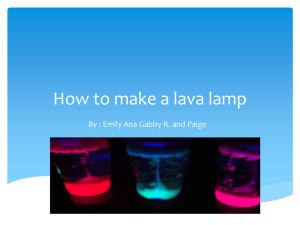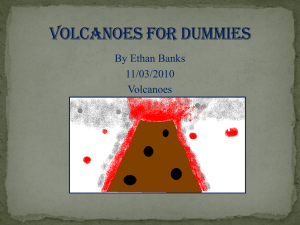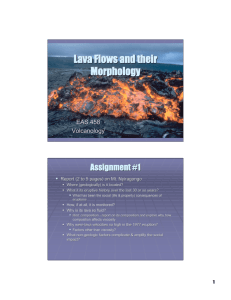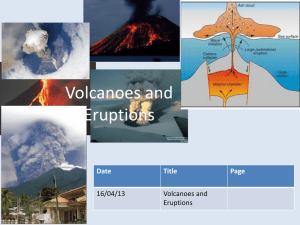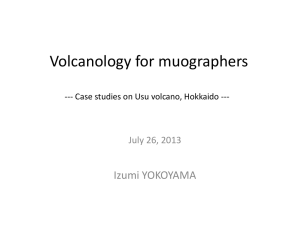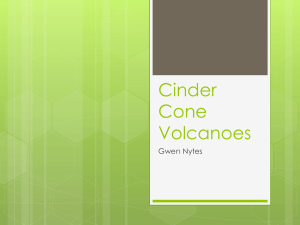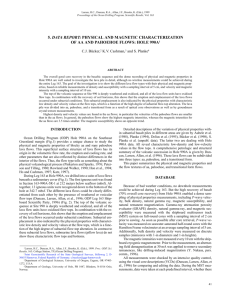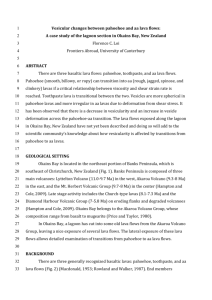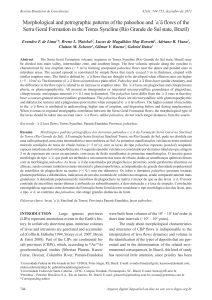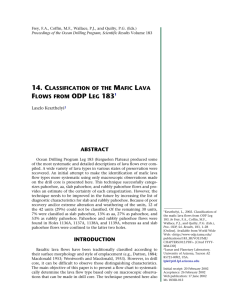Lava_flows_GG104
advertisement
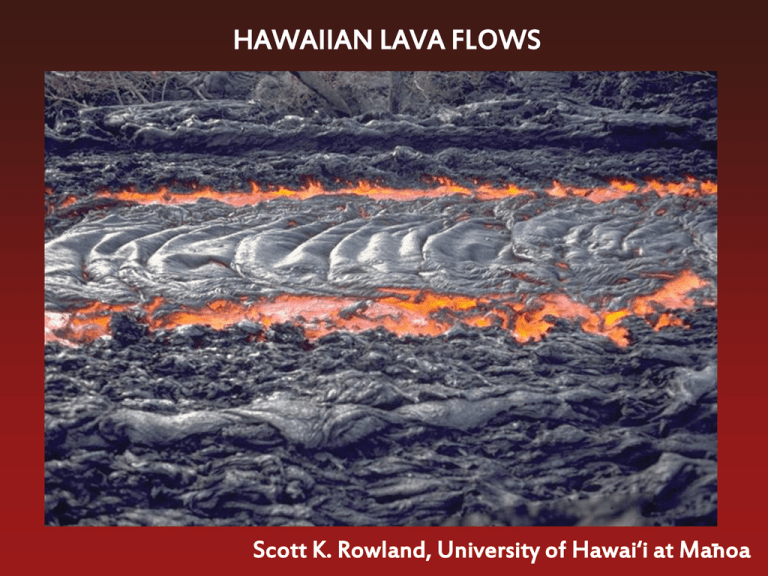
HAWAIIAN LAVA FLOWS For best results, install the font file (TECHNCLN.TTF) that is in this same directory. Scott K. Rowland, University of Hawai‘i at Manoa Lava flows: ‘a‘a- and pahoehoe From Hawaiian Dictionary by M.K. Puku‘i & S.H. Elbert - 1. To burn, blaze, glow; fire; staring, as eyes. Fig., angry, ‘a‘a: fury. Ua ‘a‘a-‘ia au i ke aloha (I burn with love). 2. stony, abounding with ‘a‘a- lava. pahoehoe: 1. Smooth, unbroken type of lava. 2. Satin. 3. to drive fish into a net by beating the paddles rhythmically against the canoe. Lava flows: ‘a‘a- and pahoehoe These two types of flow are identical chemically, their differences are due to different emplacement processes (flow rates, cooling rates, etc.). - - - to gush, ooze forth Pahuhu: Ho‘opohaku: to harden, as lava (Courtesy of Ululani Makue) ‘a‘a-high volumetric flow rate (10-103 m3 s-1) -high flow-front velocity (102-104 m hr-1) -develops large channels -few, large flow units -thick (1-10 m) flow units -higher viscosity -higher yield strength -slightly cooler -“apaluhraun” (rough lava) in Icelandic pahoehoe -low volumetric flow rate (<10 m3 s-1) -low flow-front velocity (1-10 m hr-1) -develops lava tubes -innumerable flow units -thin (10-100 cm) flow units -lower viscosity -lower yield strength -slightly hotter -“helluhraun” (pavement lava) in Icelandic These terms are “…the barbarous expressions of an insignificant and uncivilized race in a small archipelago in the Noth Pacific…” (Bonney, 1899) Stone for making implements: - lots of vesicles, easy to shape by “pecking”, Pohaku ‘eleku, (usually the interior of a pahoehoe flow) - few or no vesicles, breaks along planar fractures, Pohaku ‘ala, difficult to shape but good for cutting tools (the core of an ‘a‘a-flow or dike rock) Note that the personal preferences of the stone worker entered into the decision as well, as shown by portions of an interview of Herbert Kuumi Kin In (HKI) by William Meinecke (WM) and Mary Kawena Pukui that contains the following: WM: Ah no, the ‘āla was too smooth. Stones with little holes, that’s this. HKI: Yes, coarse, vesicular basalt. That is the pōhaku ‘elekū WM: ‘Elekū, that’s right. HKI: Good stone for hewing. Pōhaku ‘alā, hard, one has to handle carefully they break. WM: There’s one fault, that makes people dislike the ‘alā, because it’s not porous at the base, and the stone slips when pounding poi. HKI: Ah, I prefer the ‘alā. (Bishop Museum Archives Manuscript/Typescript no. HAW ID5.7.1, typescript pp. 18-19) ‘a‘a- and pahoehoe flows on the north flank of Mauna Loa ~3 m Wave-cut cliff section, Makapu‘u, O‘ahu ‘a‘a- flows Proximal-type ‘a‘a- flows -relatively thin -vesicular interior -thin top and bottom clinker layers When moving, the incandescent interior is deforms fluidly ~1 m The top surface is relatively small, spiny clinkers Distal-type ‘a‘a-flows standard geologists for scale Distal-type ‘a‘a- flows: -dense, angular, large surface blocks -incandescent lava has a high yield strength -advance is by avalanching of loose blocks and fine material George Walker, walking around on the surface of the (active) 1984 Mauna Loa distal-type ‘a‘a -lava flow Three relatively thin ‘a‘a- flows in cross section clinker flow cores Accretionary lava balls ~1.5 m diameter pahoehoe flows Flow field of pahoehoe “toes” (individual flow units) ~0.5 m Old pahoehoe flows in cliff section, Kaua‘i ~2 m pahoehoe issuing from a crack in a previous toe ~40 cm active pahoehoe toe ~20 cm Stretched vesicle walls on the skin of s-type pahoehoe ~10 cm The interior of an s-type (“spongy”) pahoehoe flow Folding of the plastic surface crust: ropy pahoehoe Side view into an active lava tube Master lava tubes can be many meters high and wide. Note that during a tube-fed eruption, the main tube is almost as long as the flow, but that afterwards it almost never drains completely. Lava trees (~2 m high) A forest of lava trees, partially buried by scoria ‘Olelo no‘eau involving lava (from M. K. Pukui; compiled by Ululani Makue O ka la- ko luna, o ka pahoehoe ko lalo. The sun above, the smooth lava below. Said of a journey in which the traveler suffers the heat of the sun above and the reflected heat from the lava below (a difficult trip). - - ke ‘ala, - uwe - ka mamane. Kike When the boulders clash, the mamane tree weeps. Meaning that when two people fight, those that are dear to them often weep. PAU Solidified dikes are exposed by erosion on old Hawaiian volcanoes If a whole lot of dikes are exposed, it means that erosion has exposed the core of an old rift zone Here are a whole bunch of dikes in a roadcut near Windward Community College (unfortunately they’re now covered by a wall). Photo by F. McCoy The axis of one of the Wai‘anae Volcano rift zones is exposed in the cliff at Kaneana. Makua cave Farrington Hwy. Dike rock is usually more resistant to erosion than the lava flows that the dikes are cutting through. They end up standing above the moreeroded flows to form narrow blade-like ridges.

